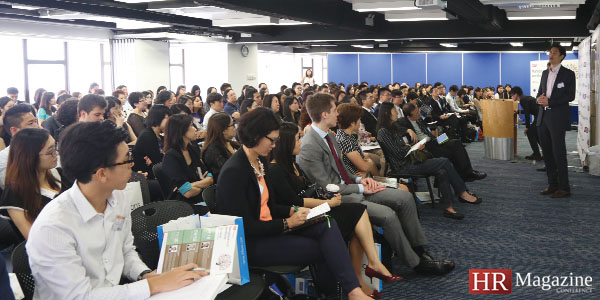
The workforce of the 21st Century presents more challenges for HR than ever before when it comes to creating an environment that fosters diversity and inclusion among its people. Knowing how to cater to the needs of up to three generations of employees from multiple cultural backgrounds, whilst attracting and developing the very best talent available, is no mean feat for any organisation.
What can companies do to meet the expectations of a multicultural, multigenerational workforce and how can they implement this at every level within the organisation? This was the question put to the guest speakers at the latest HR Magazine conference in which more than 250 HR practitioners gathered together to gain insights, advice and success stories from organisations than are striving to better manage and train up today’s increasingly diverse workforces.
Leveraging employer brand, mobile recruitment strategies and Gen-Y initiatives to foster D&I
Eric Yee, Head of Talent Solutions for HK, Macau and Taiwan, LinkedIn

The key to making mobile recruitment work for you is making it easier to facilitate contact with the right people. He advised companies to create a LinkedIn company page and design it with its desired audience in mind: students, interns, entry level, etc. He added, “Your company profile should be concise, maximum 50 – 100 words about you and what you do.” He also suggested a career page for prospective candidates, with videos and testimonials. The power of this approach is that it is accessible to all: large multi-national companies, SMEs and jobseekers—whether passive or active.
Diversity and inclusion advice from Hotel ICON
Francis Lau, Director of Human Capital, Hotel ICON

“Character is key,” explained Lau, “We hire attitude but train skills, therefore when it comes to recruiting new talent, it is crucial to question whether the candidate sitting in front of us possesses the same characteristics as the organisation and will make a good fit.” As well as assessing the individual, the characteristics of Gen Y are also taken into consideration and the hotel aims to cater to the needs of a young workforce, which not only seeks a fun workplace with a good work/life balance, but one that allows them to meet the high expectations they set for themselves in terms of their ongoing professional development.
The use of modern technology is also a fundamental element in meeting the needs of Gen Y, who like to be surrounded by technology. Lau pointed out the importance of adapting to these desires in order to attract and retain the best people. “Gen Y know what they want and they like to be informed and have the opportunity to integrate technology into their professional lives. We use technology to make the process of training fun.” This entails using a Facebook community to connect all staff in the hotel, incorporating mobile learning by inviting students to use their mobile devices to participate in group activities and deliver presentations in an interactive way.
Recruiting diverse workforces by strengthening your ‘Integrity Firewall’
Kannan Chettiar, Regional Director, First Advantage

Chettiar shared, “First Advantage uses a variety of very wide reaching checks.” With the consent of the candidate, their finances, criminal and educational records are checked and their employment history is confirmed. Chettiar indicated that discrepancies in people’s CVs regarding their previous salary, title, and reason for leaving are some of the most common lies people use hoping for a better starting salary and position. He said, “We found one candidate who indicated on their CV that they had left their previous position for family reasons. After contacting their employer it was found he was dismissed for low performance.” First Advantage apparently also discovers a number of candidates with previous criminal convictions for everything from drug trafficking to embezzlement. That in mind, First Advantage provides insurance in the event that a candidate vetted by them is discovered to have represented themselves dishonestly.
Nurturing a diverse workforce, maintaining an inclusion environment & managing diverse work practices
Brian Ho, Executive Director, Human Resources, Ocean Park Corporation

Whether employees are cleaning, performing, operating food and drink outlets, organising events or selling merchandise in the park, the company has adopted a flexible situational staffing model, which allows people to work together in different shifts within the same environment. The park has implemented several diversity and inclusion programmes, which enable fair treatment among staff members as well as give them the opportunity to voice their ideas and concerns. In addition, it offers a Selective Placement Trainee Programme, whereby around a dozen disabled staff are recruited each year from NGOs on a nine-month assignment, after which they are assessed and offered more permanent contracts with the park if suitable. The company has also implemented a strict code of conduct, which includes policies aimed at promoting equal opportunities and abides by anti-discrimination laws in Hong Kong. Ho pointed out, however, that the park does not operate on a quota system and always hires on ability, rather than favouring those with disabilities. In addition, the company recruits ethnic minorities as well as those who have been convicted of criminal offences and have undergone rehabilitation, subject to background checks and screening.
Inculcating diversity & inclusion through management and leadership programmes
Johan G van Vuuren, Director, People & Culture (AP), Dimension Data Asia Pacific

Diversity is important to Dimension Data’s operations as it is central to their philosophy of providing outcomes rather than just simply technology. Diversity gives their operations a wider range of skills and viewpoints; this allows them to adapt to a wider variety of situations and react to developments more effectively. Diversity helps clients as it means that Dimension Data has a better understanding of the needs and culture of their clients, allowing them to tailor better fitting solutions to their clients needs. Van Vuuren said that one of the most important tasks of organisations today is to, “Harness diversity rather than see it as an obstacle.” It would seem that Dimension Data is one organisation that has harnessed diversity effectively.
Fashioning Gen Y to better fit a diverse workforce—economics@UEA
Dr Matthew Aldrich, Lecturer in Economics and Employability Officer, School of Economics, Faculty of Social Sciences, University of East Anglia (UEA)

As a university, UEA is responsive to the needs and expectations of the students and aims to explore a variety of teaching pedagogy and allowing students to find their own passion within the discipline. At the same time, however, the university is adamant not to ‘drip feed’ information to students and instead teaches students how to learn for themselves. In terms of career development, the institution allows students to explore and develop soft skills needed to secure employment and develop in their careers. It also offers careers coaching to help students discover their passion and chosen career path, regular talks from alumni students and employers about how they found their path, as well as training on how to write effective CVs and network through social media such as LinkedIn. Aldrich explained that internships have proven to be a successful method to integrate students into a firm and allow them to experience what it is like to work for an organisation and assess whether it matches with their own values. He also stressed the importance of providing feedback to candidates who have come to expect it from the recruitment process. He finished by offering the advice, “Don’t be scared of giving students responsibility, they will always step up to the challenge. It provides them with an opportunity to learn and grow.”
Diversity and inclusion advice from Ernst & Young
Anne-Marie Balfe, Director, Talent Leader, Financial Services

In its most recent report, Hang Seng reported that the representation of women on boards has stalled at 9% over the last nine years. Balfe opined, “Women make up 65% of all law graduates, and yet only 14% go on to become partners of law firms. At a time when businesses are dealing with difficulty in recruiting and retaining talent, they are missing out on 50% of the population by limiting their talent pool.”
The solution is better board governance and risk awareness, and a change in attitude that is long overdue. Balfe continued, “This is necessary because it’s imperative to the success of the business. This is not simply a ‘nice-to-do’ gesture. It is easier to effect change from the top-down than from the bottom-up, but even then, it doesn’t happen overnight. This is an area in which China is making huge progress.”
Businesses should examine their own data and understand their own organisation. It is important that they are aware of any unconscious bias that might exist. Balfe offered, “Check your promotional representation. Dig in and examine what percentage of your workforce are female, and what percentage of them hold senior positions.” Businesses should also check that performance reviews are conducted equally, and that panel interviews use as diverse a panel as possible.
Within a gender-imbalanced corporate environment, however, it is the men that are most needed to effect the change. Balfe insisted, “Get men on board! Corporate competition is healthy and vital to sustained business growth. Ensure that all training packages incorporate diversity awareness so that participants can become the champions of change.”



